As an experienced man is worth two, we had multiplied the entry points to maximise the chances of meeting our man. A wish to protect himself? Shyness? To live happily, live hidden? Through the combined efforts of our 'contacts', it was finally via the very orthodox channel of the communications agency which tries to manage this phenomenon that we met up on this Monday morning in April, aboard the giant red trimaran.
Arriving from Lorient, where the big stables shelter their warriors, covered in advertisements from head to toe, in glass and steel cathedrals, the contrast was striking. Here, at the very end of the Caradec quay at La Trinité sur Mer, Francis Joyon is preparing IDEC alone. "Usually on Mondays my father comes. But with rain forecast, I told him to stay at home." Francis prefers to work this way, in harmony with the weather and...the forecast! He can't see any use in burdening himself with a team all week if the only day of the week when the weather is fine and they can work is the Saturday...when they've left for the weekend !
Whilst the other ocean racers take advantage of the pontoon to facilitate preparation work, IDEC is far away from it. To protect it from impacts or nuisances? As in the 80s, the skipper came to pick me up in the dinghy. No whirring motor, though. He comes alongside the catway with simple, agile paddle strokes. Very kindly, he asked if I could remove the 'little' batten (a good 6 metres) he was transporting.
Having done this, the introductions were rapid. Whilst the difference in size could have you worried about compression of your phalanges, the handshake is incredibly warm. We reached the trimaran in a few of the same paddle strokes, and climbed aboard. The expression takes on its full meaning when you literally have to climb the aft crossbeam. We tinkered with the lifting rudder line. "Statistically, the most frequent damage on a round the world trip is breaking the rudder on an unidentified floating object, so we've made it so it can lift. It's the only slightly complicated system on the boat." Then the first squall arrived. We took shelter inside the famous dog house. He sat on the tilting watchkeeper's berth to starboard, and I guarded the step at the entrance. That way, he couldn't escape! Two metres square, painted white, a watchkeeping seat with a panoramic view, two cleats at the entrance to free the sheets in an emergency, and that's it. It's complicated for certain people to remain simple? Not for Francis Joyon. Leaning against the bulkhead, his head is inclined at 45° to fit under the coachroof, but a cajoling, almost child-like smile never leaves him. The faded blue gaze, almost transparent, laughing, is not faked for magazine photos. Did he have the same gaze, 'the country boy', when he started sailing school?
In any case, he wasn't satisfied with dreaming, devouring Moitessier's books, or those telling of the 'Damien's' epic. He designed, he built, at first in wood, as an 'amateur'. A first monohull, then very quickly, several catamarans. Because even when cruising, they are quicker, and therefore also go further, as far as Ireland, which at the time for many people appeared to be the other side of the world! He preferred harmony with the sea to comfort. Not having an engine, he did everything under sail. And if word links all his boats, it is simplicity. A real philosophy, which for him is the only way to last, in multihulls as in life.
And it was without a doubt because everything appeared simple to him that he took on the craziest challenges. Thus for his first composite construction, he tackled a 21-metre catamaran. Not satisfied with recovering the delaminated hulls of Elf Aquitaine II, he adapted its structure from X configuration crossbeams to parallel ones. For the mast, the same technique; he transported the mast from Jean Stalaven, 25 metres long, in 3 parts, on the roof of his car! And he is surprised that that surprises you. He is not a fan of round-the-buoys races, like the Grands Prix; fully-crewed racing for him takes place on the high seas. It was to be Cadiz-San Salvador, and a promising third place for a start. As he brought the boat back singlehanded the following winter, he realised that it was 'manageable' singlehanded. And therefore entered the 1990 Route du Rhum. A stroke of fate for some, the rules were modified at the last moment to limit the length of the boats to 60 feet (18.28m). Not a problem for Francis, who got out his jigsaw and finished the race, despite a boat which leaked everywhere, because "I hadn't sealed up everything I had cut!" he admits mockingly, like a child telling of a silly thing he had done. But although Francis Joyon is really unique, two personalities visibly command his admiration. From the first of them, Mike Birch, he has remembered the example of 'always bring the boat back'. He remembers the Canadian sailing up the river Crac'h, with a broken shroud, but having saved the mast by the right manoeuvre at the right time. Of the second, the architect Nigel Irens, he says that he has 'the genius', that without a computer or a big team, his simple intuition has been at the origin of numerous developments of modern multihulls, notably the lengthened bows that we find on all the latest boats built.
It was however a Thompson-designed boat, the superb 'Paragon', that Francis then purchased. This was the blessed era when 'sponsors were looking for a boat'. And he is not insensitive to the fact that he was the first to have a contract with Banque Populaire, which today is a major sponsor of sailing in France. A lot of ground covered, when you realise that at that time, the budget for the two-up transatlantic race was 70,000 francs (10,670 euros) and was managed by the local branch. Afterwards, he freely, and with no bitterness, admitted that his way of operating was not necessarily compatible with a big group, where everything was decided in Paris.
Finally, Francis Joyon is a loyal man, who has only worn the colours of three sponsors in a 25-year career. BPO first, then the Eure et Loire 'département', where he comes from, and with which he had a superb victory in the 2000 English Transat. And finally Idec, who accompanied him in his victorious records campaign, including the famous round the world record in a little more than…57 days! A strong relationship, marked by simplicity and humanity, to which Francis Joyon insisted on associating the ICM (Insitut du Cerveau et de la Moëlle épinière) whose logo is written in huge white letters on the red hull. The relationship is simple. He will work out the year's programme directly with the big boss of IDEC at their coming meeting. There is a possibility of a singlehanded round the world race next year, or in two years' time, depending on the sponsors' wishes - his and Thomas's in particular. Francis is waiting calmly, but will be ready in time, and undeniably, a serious contender.
I offer to give him a hand. But a mooring line to be re-tensioned as the wind freshened led to "I'll grab this opportunity to take you back ashore". Economical with words, economical with gestures, everything is important, everything is efficient - the habits acquired from sailing round the world singlehanded. I didn't want to disturb or break the harmony which radiates between this man and his boat. I could however have spent hours listening to the silences, watching for the right gesture, meeting the knowing glance, admiring the almost intense relationship of a man with his sailing boat. But the clock wasn't important, the encounter was one of those that mark you and make you question your own existence, your career, your relationship with the sea, and even with your boat. A real lesson in life, unintentionally, quite simply.
 Vote for your favorite multihulls!
Vote for your favorite multihulls! 

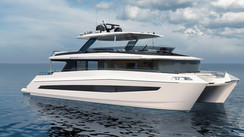
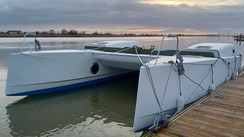
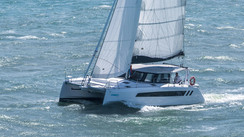
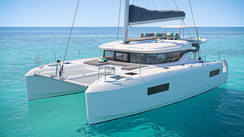
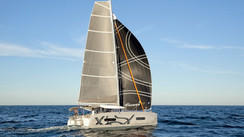
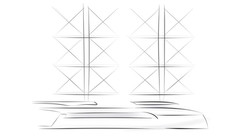
What readers think
Post a comment
No comments to show.